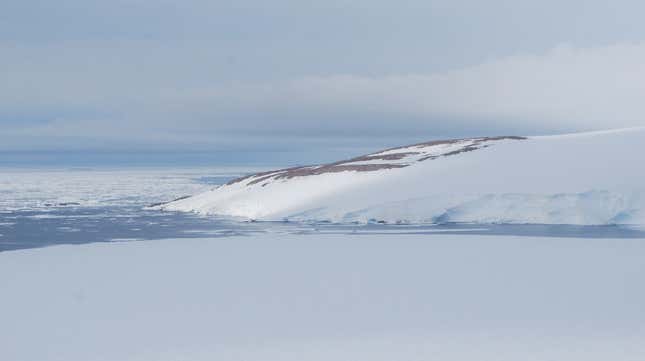
A biologist working off the Ross Sea in Antarctica has stumbled upon an assortment of Adélie penguin remains, some of which appeared to have died only recently. Turns out these dead penguins are actually quite ancient, having been newly exposed by the effects of global warming.
Four years ago, biologist Steven Emslie was perusing the Antarctic coastline on Cape Irizar of the Ross Sea when he came across the remains of Adélie penguins. He recognized them as such not from their appearance but by the unusual number of pebbles piled onto the area, which these penguins use to make nests. Many of the penguin carcasses, most of them chicks, appeared to be degraded and quite old, but a few looked as though they had died recently.
That the remains of freshly deceased Adélie penguins could be found at Cape Irizar didn’t seem possible to Emslie. Today, the Ross Sea hosts nearly 1 million breeding pairs of Adélie penguins, but no active penguin colony has ever been observed on this spot since it was first explored by British explorer Robert Falcon Scott in the early 20th century.
As he continued to explore the area, Emslie found jumbles of penguin bones strewn across the surface, but also chick carcasses still covered in feathers. The degree of degradation seen on these chicks were consistent with what one might expect from carcasses found at the sites of modern colonies. He also found guano stains, which once again pointed to a recent occupation.

Figuring he found something important, Emslie summoned his colleagues to the site, where they extracted samples from the pebble mounds. As he explained in a statement issued by the Geological Society of America, his team “excavated into three of these mounds, using methods similar to archaeologists, to recover preserved tissues of penguin bone, feather, and eggshell, as well as hard parts of prey from the guano.” Emslie said the soil was “very dry and dusty, just as I’ve found at other very old sites I’ve worked on in the Ross Sea,” which also yielded abundant numbers of penguin remains.
Radiocarbon dating of the remains affirmed Emslie’s suspicions—that the remains must be very old, despite their fresh appearance. What he didn’t expect was just how old.
Results showed that “the remains are actually ancient and that three periods of occupation by Adélie penguins are represented,” the oldest of which date back some 5,000 years ago, while the most recent occupation ended around 800 years ago, according to the paper published in the journal Geology.
“In all the years I have been doing this research in Antarctica, I’ve never seen a site quite like this,” said Emslie in the statement.

Emslie said conditions for the penguins were ideal between 4,000 to 2,000 years ago, as it was a warm period of “enhanced marine productivity.” Eventually, however, each of the three documented occupations ended, likely due to increased snow cover over the cape or encroaching sea ice caused by cooling temperatures. Penguins caught at the very tail-end of their occupations left corpses behind that became covered in snow and ice, preserving them until now.
These ancient dead penguins have only recently poked through the snow and ice, which explains their fresh appearance. Unsurprisingly, Emslie, the lone author of the paper, said this can be attributed to climate change. As the paper points out, the annual temperature in the Ross Sea has increased 2.7 to 3.6 degrees Fahrenheit (1.5 to 2 degrees Celsius) since the 1980s, while satellite images of the area taken since 2013 show that the rocky cape is increasingly coming into view as the snow and ice melt.
Climate change has resulted in some interesting scientific discoveries of late, but the grim reality is that all this warming is poised to do more harm than good when it comes to studying the past.